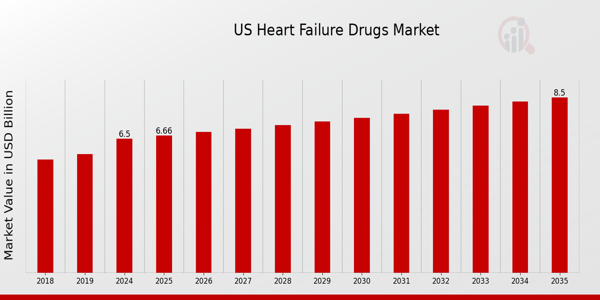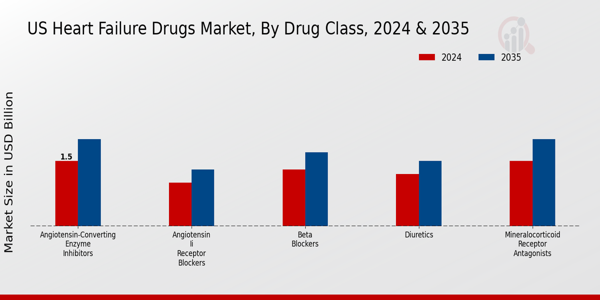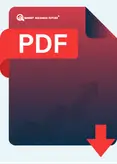US Heart Failure Drugs Market Overview:
As per MRFR analysis, the US Heart Failure Drugs Market Size was estimated at 5.86 (USD Billion) in 2023. The US Heart Failure Drugs Market Industry is expected to grow from 6.5(USD Billion) in 2024 to 8.5 (USD Billion) by 2035. The US Heart Failure Drugs Market CAGR (growth rate) is expected to be around 2.469% during the forecast period (2025 - 2035).
Key US Heart Failure Drugs Market Trends Highlighted
The US Heart Failure Drugs Market is undergoing expansion alongside other branches of the drug market, which shows new trends within the treatment of cardiovascular diseases. One of the primary shifts is fueled by the ever-growing aging population within the US, which is experiencing more cases of heart failure alongside diabetes and hypertension. This change certainly highlights the possibility for new medications and therapies to be developed, as patients are in urgent need of high quality medications. In addition, the developing technologies of drug formulation and delivery systems are greatly improving the compliance and treatment results of patients, marking a positive shift toward more tailored medicine in cardiology.
Further investigation into combination therapies offers new avenues to be explored. The combining of different classes of drugs in order to obtain optimum efficacy with minimal side effects has started to capture attention. This not only solves the multi-dimensional nature of heart failure but also meets the contemporary clinical practice guidelines which focus on multidimensional treatment approaches. As far as treatment approaches to heart failure are concerned, there's an evident shift towards the adoption of modern techniques that provide patients with a better quality of life. Furthermore, it appears that the regulatory landscape in the US is becoming more favorable, with the FDA paving the way for faster therapeutic agent approval.
This type of heart failure proactive approach motivates pharmaceutical companies to research and develop new treatment drugs to address unmet clinical needs. As a whole, these trends indicate the presence of an evolving market that is innovatively addressing patient needs and, at the same time, incorporating advanced treatment paradigms. The primary goal of addressing patient outcomes places the United States Heart Failure Drugs Market on the path toward enduring growth and positive change in the foreseeable future.

US Heart Failure Drugs Market Drivers
Growing Prevalence of Heart Failure
The incidence of heart failure is on the rise in the United States, primarily due to an aging population and the increasing prevalence of risk factors such as hypertension, diabetes, and obesity. According to the Centers for Disease Control and Prevention (CDC), approximately 6.2 million adults in the United States are currently living with heart failure. With the number of patients projected to increase, the demand for effective heart failure drugs in the US Heart Failure Drugs Market Industry is expected to escalate.
Moreover, a report from the American Heart Association highlights that by 2030, the number of heart failure cases may rise to 8 million, which directly correlates with the need for innovative therapies and medications.
Technological Advancements in Drug Development
Innovations in drug formulation and delivery systems significantly enhance the efficacy and safety of heart failure medications. The US Heart Failure Drugs Market Industry is benefiting from advancements in Research and Development (R&D), including targeted therapy approaches and personalized medicine. Organizations such as the Food and Drug Administration (FDA) have been actively promoting expedited programs for the approval of new heart failure therapies.
The recent approval of innovative medications, like Entresto, has demonstrated improved outcomes for heart failure patients, paving the way for future drug development, which is essential for reflecting the evolving medical landscape.
Rising Healthcare Expenditure
In the United States, healthcare expenditure has been consistently rising, with a significant portion allocated towards the treatment and management of chronic diseases like heart failure. According to the Centers for Medicare & Medicaid Services (CMS), national health expenditures are projected to reach over 20% of the Gross Domestic Product (GDP) by 2027. This increasing investment in healthcare provides additional funding and resources for the US Heart Failure Drugs Market Industry, allowing pharmaceutical companies to invest more in the development of innovative heart failure treatments that can enhance patient care and outcomes.
US Heart Failure Drugs Market Segment Insights:
Heart Failure Drugs Market Drug Class Insights
The Drug Class segment of the US Heart Failure Drugs Market plays a critical role in establishing treatment protocols for heart failure, which affects millions of Americans each year. With a substantial percentage of the population over 65 being diagnosed with heart-related ailments, the Drug Class segment is vital for addressing the escalating demand for effective treatments.
Among the key categories within this segment, Angiotensin-Converting Enzyme (ACE) Inhibitors are recognized for their effectiveness in reducing mortality rates among heart failure patients, as they help in preventing further deterioration of heart function. Likewise, Beta Blockers are widely utilized for their ability to decrease heart rate, thereby enhancing cardiac output and improving patient quality of life.
Diuretics also hold considerable importance in managing heart failure, offering symptomatic relief by reducing edema and setting a foundation for more effective treatment with other heart failure medications. Additionally, Angiotensin II Receptor Blockers (ARBs) are emerging as alternatives to ACE Inhibitors, providing similar benefits while offering a favorable side effect profile that can be advantageous for certain patient populations.
Furthermore, Mineralocorticoid Receptor Antagonists have gained traction in recent years, particularly for their role in addressing fluid retention and improving heart efficiency, thus contributing to better long-term outcomes.
The growing prevalence of heart failure in the United States, in conjunction with an aging population, serves as a significant growth driver for this segment. As healthcare providers increasingly focus on individualized treatment strategies, these drug classes collectively reflect a diversified approach to managing heart failure, allowing for tailored therapeutic options to meet specific patient needs.
Moreover, ongoing Research and Development efforts continue to refine existing therapies and investigate novel agents that may further elevate the efficacy of heart failure treatment.
Trends within the US Heart Failure Drugs Market indicate a marked increase in awareness regarding the condition, driving demand for effective treatment plans. However, despite advancements, challenges such as high costs of medications and varying response rates among patients remain a constant concern.
This Drug Class segment not only signifies the burgeoning scope of heart failure management but also opens avenues for innovations in drug formulations and personalized medicine approaches that could enhance patient outcomes over time. Overall, the Drug Class segment stands as a crucial pillar within the US Heart Failure Drugs Market, demonstrating its value in shaping treatment landscapes and improving the quality of life for heart failure patients nationwide.

Heart Failure Drugs Market Administration Route Insights
The Administration Route segment of the US Heart Failure Drugs Market plays a crucial role in the effective treatment and management of heart failure, addressing the specific needs of patients.
The market's growth is driven by an increasing prevalence of heart failure in the United States, partly due to rising cardiovascular diseases and an aging population. Among various methods, the oral administration route is significant because it enhances patient compliance and convenience, allowing individuals to manage their conditions with ease at home.
In contrast, intravenous administration is essential for those requiring immediate therapeutic action, particularly in acute care settings, while subcutaneous injections provide an alternative for patients who may have difficulty with oral medications.
As the US Heart Failure Drugs Market continues to evolve, healthcare providers recognize the importance of optimizing the administration route to improve overall patient outcomes and adherence. With ongoing advancements in formulation and drug delivery systems, these administration methods are expected to adapt, thereby enhancing the efficacy and safety profiles of heart failure therapies.
Heart Failure Drugs Market Patient Type Insights
The US Heart Failure Drugs Market is significantly influenced by the classification of patient types, which includes Acute Heart Failure, Chronic Heart Failure, and Heart Failure with Preserved Ejection Fraction. Each of these categories plays a critical role in the overall market dynamics.
Acute Heart Failure is often characterized by sudden onset symptoms, requiring immediate medical intervention and a range of therapeutic options that are essential for effective management. Conversely, Chronic Heart Failure represents a long-term condition that necessitates ongoing treatment strategies aimed at improving quality of life and managing symptoms.
Heart Failure with Preserved Ejection Fraction holds particular importance, as it often presents specific challenges in diagnosis and treatment, posing a notable opportunity for pharmaceutical advancements. The differing treatment needs across these patient types drive the demand for diverse drug options, emphasizing the need for ongoing Research and Development to cater to these unique requirements, thereby shaping the US Heart Failure Drugs Market segmentation effectively. As the patient population continues to grow, understanding the nuances of these types is crucial for stakeholders aiming to navigate the complexities and opportunities within the market.
Heart Failure Drugs Market Distribution Channel Insights
The US Heart Failure Drugs Market, particularly within the Distribution Channel segment, plays a pivotal role in ensuring the availability and accessibility of essential medications. The distribution channels are primarily classified into Hospital Pharmacy, Retail Pharmacy, and Online Pharmacy, each serving a vital function in the healthcare landscape.
Hospital Pharmacies are particularly significant as they provide immediate access to heart failure drugs for patients during critical care situations, enabling timely treatment and management of acute heart conditions.
Retail Pharmacies offer convenience and are essential for ongoing medication management, promoting adherence to prescribed therapies among patients through easy access and consultation.
Meanwhile, Online Pharmacies have gained traction due to increasing demand for convenient healthcare solutions, especially as patients seek to manage their prescriptions from home.
This digital shift has been further accelerated by the COVID-19 pandemic, which has made remote healthcare options more desirable. Overall, each of these channels contributes uniquely to the US Heart Failure Drugs Market, catering to diverse patient needs and preferences while addressing the growing incidence of heart failure across the nation.
US Heart Failure Drugs Market Key Players and Competitive Insights:
The US Heart Failure Drugs Market has witnessed significant growth and transformation in recent years, driven by advancements in medical research, an aging population, and increased awareness about cardiovascular diseases. With a competitive landscape characterized by numerous pharmaceutical companies, the evolution of treatment options has opened up various avenues for patients suffering from heart failure.
Key players in the market strive to innovate and develop therapies that improve patient outcomes, offering a range of medications, including angiotensin receptor-neprilysin inhibitors, beta-blockers, and SGLT2 inhibitors. This competition has led to enhanced therapeutic options and has propelled companies to focus on not only drug efficacy but also safety profiles, ultimately leading to a robust and diverse market catering to the needs of healthcare providers and patients alike.
AstraZeneca has established a prominent presence in the US Heart Failure Drugs Market, leveraging its commitment to research and development to deliver innovative treatment options. The company's strategic focus on heart failure reflects its broader mission to address unmet medical needs and enhance the quality of life for patients. AstraZeneca's strengths lie in its robust product pipeline and a comprehensive understanding of cardiovascular diseases, bolstered by its established relationships with healthcare professionals.
By continually investing in clinical trials and engaging in partnerships, AstraZeneca has positioned itself to advance the science of heart failure management, thus solidifying its reputation within the market. The company's capabilities in formulating effective therapies further affirm its significance in addressing the challenges posed by heart failure.
Micromet has carved out a niche in the US Heart Failure Drugs Market, primarily through its innovative approach to treatment solutions. The company's key products focus on addressing the underlying mechanisms of heart failure, showcasing its commitment to improving therapeutic outcomes. Micromet has worked on distinctive therapies aimed at enhancing heart function and quality of life for patients, reinforcing its market presence through both efficacy and safety.
Strengths of Micromet include its rigorous research initiatives and partnerships that aim to bring advanced therapies to the forefront. The company has also pursued strategic mergers and acquisitions to bolster its research capabilities and expand its product offerings, driving growth within the competitive landscape of heart failure drugs in the US market. Through these endeavors, Micromet continues to establish a strong foothold while advancing the treatment paradigm in heart failure management.
Key Companies in the US Heart Failure Drugs Market Include:
- AstraZeneca
- Micromet
- Merck
- Roche
- Amgen
- Cardinal Health
- Bristol Myers Squibb
- GlaxoSmithKline
- Sanofi
- Johnson & Johnson
- Abbott Laboratories
- Gilead Sciences
- Eli Lilly
- Pfizer
- Novartis
US Heart Failure Drugs Market Industry Developments
The US Heart Failure Drugs Market has seen several significant developments recently. AstraZeneca's heart failure medication, Farxiga, has shown promising results in clinical trials, contributing to the company's growth and solidifying its position in the market. Merck has made strides with its SGLT2 inhibitor, showing efficacy in treating heart failure, while Bristol Myers Squibb continues to expand its portfolio with innovative therapies. Notably, in July 2023, Eli Lilly announced its acquisition of a promising heart failure treatment from the startup company, effectively increasing its market presence. Companies like Gilead Sciences and Roche are also innovating their cardiovascular drug lines. The overall market growth has resulted in an increase in market valuations for major firms, significantly impacting their Research and Development strategies and leading to enhanced competition. Some major happenings in the sector include Novartis's launch of a new heart failure medication in September 2022 and ongoing collaborations among major players to accelerate drug development. This collaborative environment underlines the dynamic nature of the US Heart Failure Drugs Market, driven by increased patient demand and an evolving understanding of heart failure therapies.
Heart Failure Drugs Market Segmentation Insights
-
Heart Failure Drugs Market Drug Class Outlook
- Angiotensin-Converting Enzyme Inhibitors
- Beta Blockers
- Diuretics
- Angiotensin II Receptor Blockers
- Mineralocorticoid Receptor Antagonists
-
Heart Failure Drugs Market Administration Route Outlook
- Oral
- Intravenous
- Subcutaneous
-
Heart Failure Drugs Market Patient Type Outlook
- Acute Heart Failure
- Chronic Heart Failure
- Heart Failure with Preserved Ejection Fraction
-
Heart Failure Drugs Market Distribution Channel Outlook
- Hospital Pharmacy
- Retail Pharmacy
- Online Pharmacy
|
Report Attribute/Metric
|
Details
|
|
Market Size 2018
|
5.86(USD Billion)
|
|
Market Size 2024
|
6.5(USD Billion)
|
|
Market Size 2035
|
8.5(USD Billion)
|
|
Compound Annual Growth Rate (CAGR)
|
2.469% (2025 - 2035)
|
|
Report Coverage
|
Revenue Forecast, Competitive Landscape, Growth Factors, and Trends
|
|
Base Year
|
2024
|
|
Market Forecast Period
|
2025 - 2035
|
|
Historical Data
|
2019 - 2024
|
|
Market Forecast Units
|
USD Billion
|
|
Key Companies Profiled
|
AstraZeneca, Micromet, Merck, Roche, Amgen, Cardinal Health, Bristol Myers Squibb, GlaxoSmithKline, Sanofi, Johnson & Johnson, Abbott Laboratories, Gilead Sciences, Eli Lilly, Pfizer, Novartis
|
|
Segments Covered
|
Drug Class, Administration Route, Patient Type, Distribution Channel
|
|
Key Market Opportunities
|
Aging population, increasing demand, Innovative drug development potential, Expanding telemedicine integration, Rising awareness and screening initiatives, Enhanced patient adherence solutions
|
|
Key Market Dynamics
|
Rising prevalence of heart failure, Advancements in drug therapies, Aging population, Increasing healthcare expenditure, Growing awareness and diagnosis
|
|
Countries Covered
|
US
|
Frequently Asked Questions (FAQ) :
The US Heart Failure Drugs Market is projected to be valued at 6.5 USD Billion in 2024.
By 2035, the market size of the US Heart Failure Drugs Market is expected to reach 8.5 USD Billion.
The US Heart Failure Drugs Market is expected to have a CAGR of 2.469% from 2025 to 2035.
In 2024, Angiotensin-Converting Enzyme Inhibitors are valued at 1.5 USD Billion, making it the highest among the drug classes.
The Beta Blockers segment is projected to be valued at 1.7 USD Billion by 2035.
Key players in the market include AstraZeneca, Merck, Roche, and Bristol Myers Squibb, among others.
By 2035, the Diuretics segment is expected to reach a market value of 1.5 USD Billion.
The growth is likely to be driven by the increasing prevalence of heart failure, advancements in drug formulations, and a growing aging population.
Mineralocorticoid Receptor Antagonists are valued at 1.5 USD Billion in 2024.
The market is expected to grow from 6.5 USD Billion in 2024 to 8.5 USD Billion in 2035, reflecting significant growth opportunities.
















